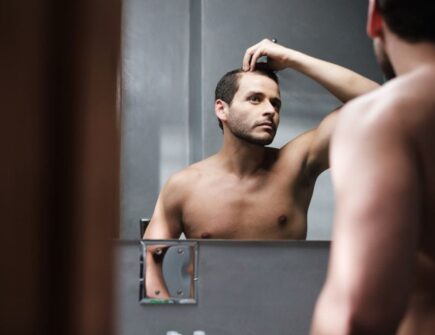Introduction
Undergoing a hair transplant is a significant step towards restoring your hair and confidence. However, the procedure’s success doesn’t just depend on the surgery itself—it also hinges on how well you care for your scalp in the days, weeks, and months following the transplant. Proper aftercare ensures the transplanted hair follicles take root, grow, and thrive, leading to the best possible results. This comprehensive guide will walk you through the essential steps of hair transplant aftercare, addressing common concerns and providing tips for optimal recovery.
Why Aftercare is Crucial for Hair Transplant Success
Aftercare plays a vital role in healing and achieving the desired outcome from a hair transplant. Immediately after the procedure, the newly implanted follicles are delicate. How you care for them during this time can significantly impact the final results. Proper aftercare minimizes the risk of complications, promotes healthy hair growth, and ensures that the transplanted hair blends naturally with your existing hair.
Immediate Post-Operative Care
What to Expect Immediately After Surgery
After your hair transplant, it’s normal to experience redness, swelling, and sensitivity in the treated areas. These symptoms are temporary and typically subside within a few days. The transplanted follicles will appear as tiny dots on your scalp, and you may feel tightness or discomfort, which can be managed with prescribed medications.
First 24-48 Hours of hair transplant
The first 24 to 48 hours after your transplant are critical for protecting the newly implanted follicles. During this period, you should:
- Keep Your Head Elevated: Sleeping your head elevated can help reduce swelling.
- Avoid Touching the Transplant Area: To prevent the grafts from dislodging, do not touch, rub, or scratch the area.
- Follow Your Surgeon’s Instructions: Carefully follow your surgeon’s aftercare instructions, including any recommendations for washing or applying topical treatments.
First Week of hair transplant
The first week after your hair transplant is crucial for the healing process. During this time, you should:
- Sleep in a Semi-Upright Position: Sleep with your head elevated to minimize swelling.
- Avoid Strenuous Activities: Refrain from heavy lifting, bending over, or engaging in any activity that could increase blood pressure to the scalp.
- Monitor for Signs of Infection: While infections are rare, it’s essential to watch for signs such as increased redness, pus, or severe pain and contact your surgeon if these occur.
Long-Term Aftercare
The First Month of the hair transplant
During the first month, the transplanted hair follicles will enter the shedding phase, where the hair shafts fall out to make way for new growth. This is a normal part of the process and should not cause concern.
- Shedding Phase: Expect the transplanted hairs to shed within the first two to three weeks.
- Scab Formation and Removal: Scabs may form over the implanted areas. To avoid disturbing the grafts, they should fall off naturally.
- Continued Care for the Scalp: Keep the scalp clean and follow your surgeon’s recommendations for washing and caring.
3 to 6 Months Post-Transplant
New hair growth will begin around three months after your transplant. This period is marked by the gradual appearance of new hairs, which may initially be thin and delicate.
- Hair Growth Timeline: New hair growth becomes noticeable around three months, significantly improving by six months.
- Handling Itching, Dryness, and Flaking: Mild itching or flaking may occur as the scalp heals. Use gentle, surgeon-approved products to alleviate discomfort.
- Products to Support Hair Growth: Your surgeon may recommend specific hair transplant aftercare products, such as shampoos or topical treatments, to support healthy hair growth during this phase.
1 Year and Beyond of hair transplant
By the time you reach the one-year mark, the full results of your hair transplant should be visible. The transplanted hair will have grown, thickened, and blended with your existing hair.
- When to Expect Full Results: Full results are typically seen around 12 to 18 months post-transplant.
- Maintaining and Enhancing Your Results: To ensure long-term success, follow a healthy hair care routine and consider periodic consultations with your surgeon.
- Regular Check-Ups and Long-Term Care: Regular follow-ups with your surgeon can help monitor the progress and address concerns.
Common Aftercare Concerns
Dealing with Shock Loss
Shock loss, or the shedding of transplanted and surrounding hairs, is common after a hair transplant. It’s important to understand that this is a temporary phase and is part of the natural healing process.
- Understanding Temporary Hair Shedding: Shock loss usually occurs within the first two months post-transplant and is a normal reaction to the surgery.
- How to Manage Anxiety During This Phase: Remember that new hair will grow in place of the shed hairs. Patience is critical during this period.
Itching and Discomfort
Mild itching is expected as the scalp heals, but it’s crucial to avoid scratching, as this can disrupt the grafts.
- Safe Remedies for Itching: Over-the-counter antihistamines or surgeon-recommended topical treatments can help alleviate itching.
- When to Contact Your Surgeon: If itching is severe or accompanied by other symptoms, such as redness or swelling.
How to Handle Infections or Complications
While infections are rare, they can occur if aftercare instructions are not followed properly. Early intervention is critical to preventing more serious issues.
- Recognizing Early Signs of Infection: Symptoms such as increased redness, warmth, tenderness, or discharge from the transplant site should be reported to your surgeon immediately.
- Steps to Take if You Suspect a Complication: Follow your surgeon’s advice for treating minor infections, and seek prompt medical attention if necessary.
Lifestyle Adjustments for Optimal Healing
Diet and Nutrition
A healthy diet can support your body’s healing process and promote hair growth.
- Foods That Promote Hair Growth and Healing: Focus on a balanced diet rich in vitamins and minerals, particularly those that support hair health, such as vitamin C, biotin, and zinc.
- Supplements to Consider: Your surgeon may recommend supplements, such as biotin or vitamin D, to enhance hair growth.
Avoiding Harmful Habits
Certain habits can negatively impact the success of your hair transplant.
- Smoking, Alcohol, and Other Substances: Avoid tobacco and limit alcohol consumption, as these can hinder healing and affect hair growth.
- Impact of Stress on Hair Growth: Stress can also contribute to hair loss, so practice stress management techniques to support recovery.
Hair Care Practices
Gentle hair care practices are essential during the recovery period and beyond.
- When to Resume Normal Hair Washing and Styling: Follow your surgeon’s hair transplant aftercare shampoo guidelines. Typically, gentle washing can begin a few days after surgery, and more vigorous washing can be resumed after the scalp has sufficiently healed.
- Products to Avoid During Recovery: Avoid harsh shampoos, conditioners, and styling products that contain alcohol or sulfates, as these can irritate the scalp and affect healing.
Common Concerns and Questions About Aftercare
Many patients have questions about what to expect after their hair transplant and how to care for their scalp during recovery. This guide aims to answer those questions, providing detailed information on every aspect of aftercare, from immediate post-operative care to long-term maintenance.
Conclusion
Proper aftercare is the cornerstone of a successful hair transplant. Following the guidelines outlined in this comprehensive guide, you can ensure that your scalp heals correctly and that your transplanted hair grows healthy and strong. Remember that every patient’s experience is unique, so it’s important to communicate closely with your surgeon throughout the recovery process. With the proper care, you can look forward to enjoying the full results of your hair transplant and the renewed confidence that comes with it.
Frequently Asked Questions (FAQs)
How soon can I return to work after a hair transplant?
Most patients can return to work within a few days, depending on the nature of their job and how well they feel. However, it’s important to avoid strenuous activities for the first week.
When can I start exercising again?
Light exercise can usually be resumed after a week, but strenuous activities should be avoided for at least two to three weeks to protect the grafts. Avoid activities that could cause excessive sweating or increase blood flow to the scalp.
Is it normal for the transplanted hair to fall out?
Yes, it’s normal for the transplanted hair to shed within the first few weeks. This is part of the shock loss phase and is a temporary step before new hair growth begins.
How should I wash my hair after the transplant?
Your surgeon will provide specific instructions on how to wash your hair. Typically, gentle washing with a mild, surgeon-recommended hair transplant aftercare shampoo can begin a few days after surgery, with more thorough washing allowed after about one week.
What should I avoid after a hair transplant?
During the first week, avoid rubbing or scratching your scalp, exposing it to direct sunlight, and washing it with hot water. Also, avoid smoking, alcohol, and strenuous physical activities for at least two weeks to aid in the healing process.
When can I rub my head after a hair transplant?
It’s important not to rub your head for at least 7 to 10 days after the procedure. Rubbing or scratching too early can dislodge the grafts and negatively impact the results.
What should I do if I experience complications?
Contact your surgeon immediately for advice and treatment if you notice any signs of infection, excessive swelling, or other concerning symptoms.







